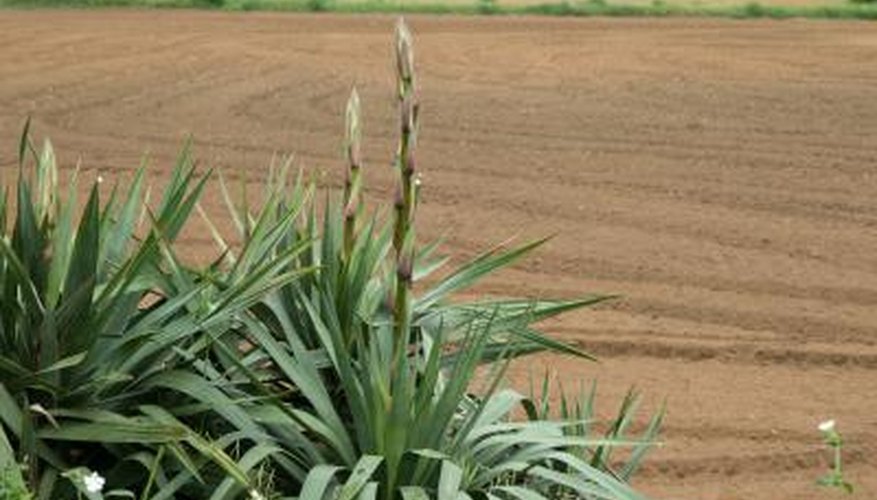Yucca plants are native to southeastern North America. The plant is a warm-season species that has long lance-shaped leaves, which give it the alternate name "Spanish bayonet." Yucca plants thrive in very inhospitable terrain and poor soils. It is also a drought-tolerant species useful for xeriscape gardening. Yucca plants have a symbiotic relationship with the yucca moth. The two organisms cannot complete their life cycles without each other and demonstrate an unusual partnership.
Characteristics
There are an unrecognized number of yucca species. Some varieties are ankle-high while others, like the Joshua tree, can grow 15 to 40 feet tall. The main shared characteristics are the leaves, which are straplike and filamentous. The foliage is long and slim, coming to a point at the end and tending to peel at the edges. The leaves are arranged in a rosette. The plant produces an inflorescence, which is a cluster of bell-shaped blooms that hang from a main stalk. The flowers may be white or green. Once the plant has flowered and successfully fruited, it dies and must regrow from offshoots or pups at the base of the original plant.
- There are an unrecognized number of yucca species.
- Some varieties are ankle-high while others, like the Joshua tree, can grow 15 to 40 feet tall.
Pollination
The only insect that pollinates the flowers of the yucca is the female yucca moth. She actually collects the pollen and stuffs it into the stigma. The construction of the flowers makes it impossible for the pollen to drop from the anthers into the stigma. Without the efforts of the female moth, the flowers would not get pollinated and could not produce seed. The female moth is also busy laying eggs in the ovary of the flowers. The pollinated flowers produce a fruit that will drop when ripe, scattering seeds that self-sow around the parent plant.
- The only insect that pollinates the flowers of the yucca is the female yucca moth.
- The pollinated flowers produce a fruit that will drop when ripe, scattering seeds that self-sow around the parent plant.
Yucca Seeds
The female yucca moth has evolved with mouth parts specially designed for collecting the pollen and making it into a ball. After she packs the pollen into the stigma of the flower, the plant produces seeds. The seeds are the main food for the yucca moth larvae. The plant is self-protective in that it seems to recognise when too many seeds are being consumed. It will drop the fruit, spreading the seeds when there is an overabundance of larvae on the fruit.
- The female yucca moth has evolved with mouth parts specially designed for collecting the pollen and making it into a ball.
Duration of Life Cycle
Some yucca species are not long-lived and complete their life cycle in five to seven years after flowering. Yucca plants are considered perennials and will persist even in colder climates. The majority of yuccas will live hundreds of years although the original plant will not persist. Instead the plant root is long-lived and reproduces new plantlets. The tap root of a yucca is huge, often reaching 60 feet in length. It has fine hairs that help the plant collect water and nutrients.
- Some yucca species are not long-lived and complete their life cycle in five to seven years after flowering.
- The majority of yuccas will live hundreds of years although the original plant will not persist.
